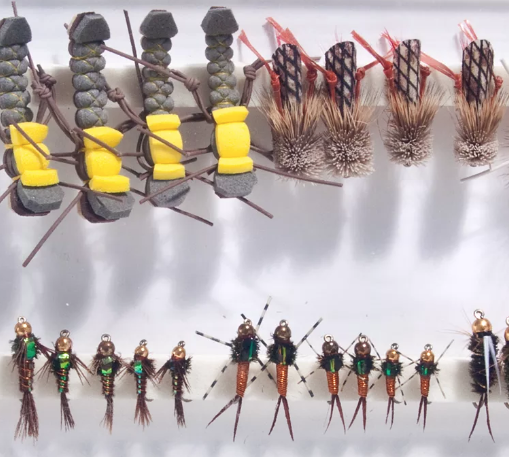By Chris Hunt
The ethics of fly fishing can get pretty sticky, or at least I’m gleaning that from social media, where some folks aren’t afraid to scold fellow anglers for teetering on the edge of angling impropriety, whether that impropriety is real or perceived.
For instance, when did using a “dropper” become taboo?
Last year, I did a short blog post here on the TU blog on the merits of the Prince Nymph—it’s a great all-around searching pattern for trout, and, in my estimation, an excellent pattern to use in heavy water where trout don’t get a lot of pressure. In other words, it’s an attractor fly that seems to work for fish that don’t see a lot of flies.
I mentioned fishing the Prince in the Fall River, a high-gradient stream that features, as the name implies, many waterfalls and more fast water than not. The good, old “hopper-dropper” presentation can be tough when you’re fishing below a 20-foot waterfall—the turbid water can drown even the foamiest of foam flies. So I switched over to a Thingamabobber, and dropped the Prince about three feet under it.
And, it’s important to note, the International Game Fish Association announced this summer that trout and salmon caught using dropper flies are now eligible for record consideration — if that’s not an endorsement of hanging a fish under a dropper fly or an indicator, I don’t know what is.
The “dropper” method is hardly a new development in fly fishing—even the most lauded fly anglers subscribe to the idea that using two flies improves their chances on the water, and the method helps with deduction, allowing an angler to pick the best of the two patterns once it’s clear the fish prefer one over the other.
Not surprisingly, in this somewhat remote river in the southwest corner of Yellowstone National Park, the Prince proved to be an excellent choice. I brought to hand a dozen or so wild rainbows, including my personal best on the Fall River, a 17-inch tailwalker that elicited “oohs” and “aahs” from the tourists watching me fish from the overlook.
It was pretty cool, honestly.
Sure, I was using a “bobber,” a method chosen out of necessity, given the circumstances and the limitations of the tackle I had on hand. Normally, I would have been perfectly happy drifting a high-floating Chernobyl through the rough water, and I would likely have caught a few trout. But this day, with some funky, unsettled weather moving through, the trout were deep and didn’t seem willing to come off the bottom, even for a big bite of protein.
So I rigged up with the “indicator” and went down to the fish.
And, on social media, I was scolded for my method.
“Barbless hooks, one fly, not two. No hopper-droppers. Wake up.” the critics-turned-ethics-cops chimed in.
Could I have ditched the indicator and used the Euro-nymphing method to reach the fish? I suppose, but conflicting currents made that choice less than ideal, at least for me. I’m sure other, more seasoned nymphers could have made it work, and I might give it a try next time I’m there.
That I had enjoyed success with the rig I chose didn’t seem to phase the readers who opted to become online ethics enforcers. I adapted to the conditions, chose a fly pattern I thought might work, and managed to catch fish.
I’m still trying to get my head around the perceived violation of some secret fly-fishing rules that I think a lot of folks are crafting as they go. Fly fishing is hard enough—especially if you’re just learning the craft. Why on earth would we make it more difficult than it already is by complicating it with strange new rules and trying to shame folks who engage in the craft in a perfectly legal—and, I would argue, perfectly ethical—fashion?
The “dropper” method is hardly a new development in fly fishing—even the most lauded fly anglers subscribe to the idea that using two flies improves their chances on the water, and the method helps with deduction, allowing an angler to pick the best of the two patterns once it’s clear the fish prefer one over the other.
But … unethical? Somehow inappropriate?
Perhaps to the purists in our ranks, but to the average angler who’s just trying to catch (and, in my case, release) a few trout?
Maybe I’m more of a troglodyte than I’d care to admit, but the overt criticism toward anglers who adapt to the conditions and figure out how to catch fish seems a bit much.
Dropping a fly under a hopper or an indicator is a perfectly acceptable method in my book. While it may not be competition-approved, how many of us are really competing when we fish?
Perhaps this is just a sign of the times. That, even among our own ranks, the desire to spur conflict and deliver criticism to others is so intense that we just can’t help ourselves. Hence, the critique on social media, where we have plenty of examples of how not to behave. Yet, there seems to be an ever-growing presence of ethics police for whom delivering unsolicited criticism for all to see is now the norm, not the exception.
And … over a dropped Prince Nymph, no less.



